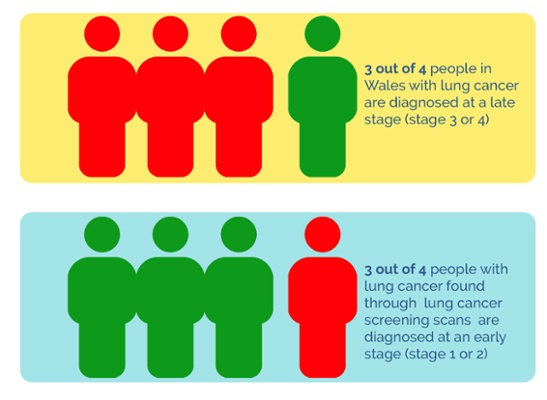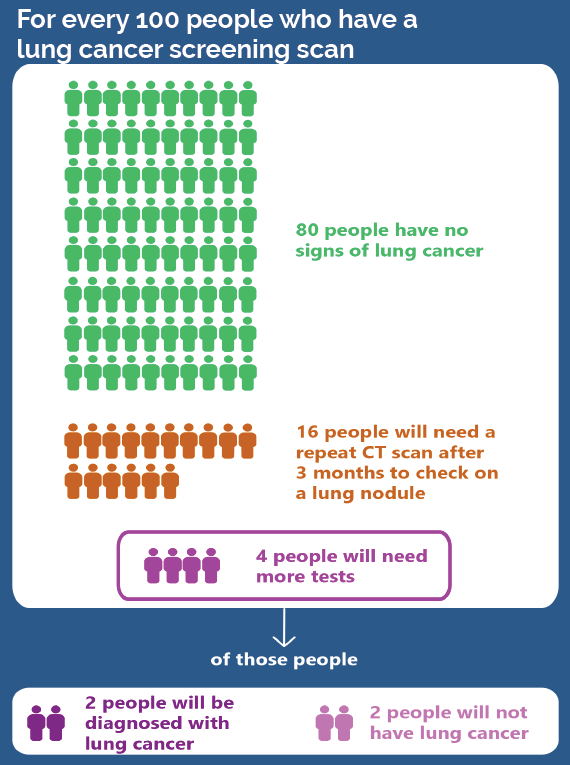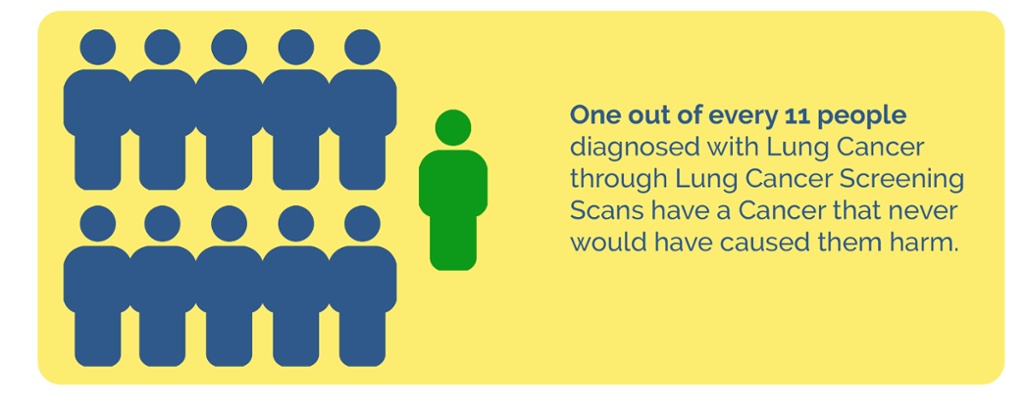What are the benefits and the risks of Lung Health Checks?
It is your choice whether to have your Lung Health Check.
The information below can help you decide.
If after reading this you want more detailed information on the benefits and risks of Lung Health Checks, this is available at the bottom of the page.
What are the benefits?
- Lung Health Checks save lives.
- Lung Cancers found through Lung Health Checks are much more likely to be at an early stage.
- When found early, treatment for Lung Cancer may be simpler and is more likely to be successful.
- Research shows that Lung Cancer screening scans can reduce your risk of dying from Lung Cancer by around 25%.
What are the risks?
Like x-rays, CT Scans use radiation to produce pictures of your lungs.
The dose of radiation from a Lung Cancer Screening Scan is much less than from most other types of CT Scan. The chance of the scan saving your life by detecting an early Lung Cancer is far greater than the chance of the scan causing you harm.
Lung Health Checks and Lung Cancer Screening Scans do not find all lung cancers.
Some people who are not offered a scan will develop Lung Cancer. Sometimes Lung Cancers cannot be seen on scans, and very occasionally a Cancer may be missed on a scan. Lung Cancers can also develop after a Screening Scan.
Some people who need further tests after their Lung Cancer Screening Scan will be found not to have Lung Cancer.
This can be worrying and cause distress.
Screening Scans can sometimes pick up a Lung Cancer that would never cause harm.
Doctors cannot always tell if a Cancer will go on to be life-threatening. This means some people will have tests and receive treatment that they would not have otherwise needed.
- I want more detailed information on Benefits and Risks
-
Benefits
The stage of a Cancer tells you how big it is and whether it has spread. Lung Cancers are divided into 4 stages, numbered from 1 to 4. Stage 1 means that the Cancer is small and hasn’t spread to your lymph nodes or other organs. The higher numbered stages mean that the Cancer has grown or has spread to other parts of your body. We call Stage 1 and Stage 2 Lung Cancers “early stage”, and stage 3 and 4 “late stage”. More information on the stages of Lung Cancer is available on the Cancer Research UK Website.
In Wales, three-quarters of Lung Cancers are diagnosed at Stage 3 or Stage 4. At these stages, Lung Cancers are more difficult to treat than at Stage 1 or Stage 2. Most cases are found at a late stage because Lung Cancer often does not cause symptoms until it has got to a later stage, or the symptoms may not obviously be due to Lung Cancer.
Lung Cancer Screening Scans can find Lung Cancers before they are causing symptoms. Three-quarters of Lung Cancers diagnosed through Lung Cancer Screening Scans are at Stage 1 or Stage 2. Lung Cancers found at an early stage are easier to treat, often by an operation to remove part of the Lung or with Radiotherapy.
By finding Lung Cancers at an earlier stage, Lung Cancer screening scans can reduce the chances of dying from Lung Cancer by around 25%.

Risks
Whilst Lung Health Checks save lives and reduce the chances of dying from Lung Cancer, as with all types of screening there are some risks.
Like x-rays, CT Scans use radiation to produce pictures of your Lungs.
The dose of radiation from a Lung Cancer Screening Scan is much less than from most other types of CT Scan. The chance of the scan saving your life by detecting an early Lung Cancer is far greater than the chance of the scan causing you harm. You may not be aware of it, but radiation is around you every day. This is called “background radiation” and occurs naturally in the environment. A Lung Cancer screening scan exposes you to the equivalent of about 6 months of background radiation.
Lung Health Checks and Lung Cancer Screening Scans do not find all Lung Cancers.
Some people who are not offered a scan will develop Lung Cancer. In order to balance the risks of Lung Cancer Screening Scans against the benefits, only people who have a higher risk of Lung Cancer are offered a Lung Cancer Screening Scan. However, some Lung Cancers will occur in people whose risk was not high enough for them to have a Lung Cancer Screening Scan. More information on how we work out who is at higher risk of Lung Cancer is in the section below on “How do we balance the Benefits and Risks”.
Sometimes Lung Cancers cannot be seen on scans, and very occasionally a Cancer may be missed on a scan. The pictures produced by CT Scans are detailed and can be complicated to interpret. Trained specialists review Lung Cancer Screening Scans to look for signs of Lung Cancer or Lung Nodules. They also use special computer software that can help find things that can be difficult to spot. Even with these measures, there will still be some Cancers or Nodules that are either not visible or not spotted on scans. Even if you have had a Lung Cancer Screening Scan, Lung Cancer can develop at any time so it is important to look out for any symptoms that are not normal for you.
Some people who need further tests after their Lung Cancer Screening Scan will be found not to have Lung Cancer.
About 4 out of every 100 people who undergo a Lung Cancer Screening Scan will need to have more tests. These tests may include more scans, a biopsy, blowing tests, and occasionally other types of tests. More information about tests for Lung Cancer is available on the Cancer Research UK Website.
Of the 4 out of 100 people who need more tests, 2 of the 4 people will be diagnosed with Lung Cancer following their tests, whilst the other 2 of the 4 people will be found not to have Lung Cancer. The medical term for this is a “false-positive” screen.

Having tests can be worrying and cause distress. The tests themselves, whilst usually very safe, also have some risks. For example, having additional scans will lead to more radiation exposure, and bleeding and infection are risks from having a biopsy. More information is available on the Cancer Research UK Website. We do these tests because the risks from them are low overall, and if we find a Lung Cancer then patients can benefit from treatment. But, some of the people undergoing the tests will ultimately be found not have Lung Cancer, and would not have had to undergo the tests if they had not had a Lung Cancer Screening Scan.
There are several reasons why more tests may be recommended after a Lung Cancer Screening Scan and then for Lung Cancer not to be diagnosed after further tests. Sometimes areas of inflammation, infection or scarring can develop in the Lungs without causing any symptoms. It is not always possible to tell the difference between these changes and a Lung Cancer on a Lung Cancer Screening Scan. That is why more tests are needed to confirm if what we can see on the scan is a Lung Cancer or not.
In addition to the 4 people who need more tests, 16 out of every 100 people who have a Lung Cancer Screening Scan will be found to have a Lung Nodule. These people will be invited for a repeat scan, usually after 3 months. A further scan 12 months after the initial scan may also be needed. This is to check to see if the Nodule gets bigger, which could indicate that the Nodule is a small Lung Cancer. Most Lung Nodules are not due to Cancer, and either stay the same or disappear over time. It is not possible to tell from your Lung Cancer Screening Scan which Nodules are likely to become Lung Cancers over time. So most people who need repeat scans will not turn out to have Lung Cancer. Knowing that you have a Lung Nodule and need repeat scans can be a source of worry and distress for some people.
Screening Scans can sometimes pick up a Lung Cancer that would never cause harm.
When people have Lung Cancer Screening Scans, we find more Lung Cancers than we would have expected to have found if those people had not undergone screening. This is because some Cancers would not have caused that person a problem or been found during their lifetime without screening. The medical term for this is “overdiagnosis”.
When we find a Lung Cancer on a Screening Scan, we cannot tell whether that Cancer is one that would go on to be life-threatening, or if it is one that would not have been found in that person’s lifetime. This means some people will have tests and receive treatment that they would not have otherwise needed.
Research shows that most Lung Cancers found through Lung Cancer Screening Scans would have been found and caused a problem eventually – though sometimes not until many years later. In a large trial done in Europe, for every 11 Lung Cancers that were found through screening, 10 would have been eventually found without screening and 1 would never have been found during the person’s lifetime. The idea of screening is to find the Cancers that would have been found at an earlier stage, when they are easier to treat.

How do we balance the Benefits and Risks?
Whilst Lung Cancer Screening Scans save lives, they do also have some risks as described above. People who are at higher risk of Lung Cancer benefit more from Lung Cancer Screening Scans, because they are more likely to have a Lung Cancer that can be found by screening. People who have a low risk of having Lung Cancer are less likely to benefit from Lung Cancer Screening Scans because the chances of finding a Lung Cancer through screening in their case is very low. If these people were to undergo Lung Cancer Screening Scans then they would still be exposed to the risks of screening, but with a much lower chance of them having any benefit from it.
Because of this, only people at high risk of Lung Cancer are eligible for Lung Cancer Screening Scans. It has not been decided yet exactly who will be eligible for Lung Cancer Screening Scans in a National Lung Cancer Screening Programme. In this Lung Health Check Programme being offered to selected Doctors’ Surgeries in CTM, there are two steps to determine who is eligible. The first is based on your age and smoking status. Only people aged 60-74 years who smoke or have smoked in the past are invited for a telephone appointment. At the telephone appointment, you will be asked a series of questions to work out the risk of you having Lung Cancer over the next 5 years. This is done using a special risk calculator that takes into account your age, family history, history of smoking and some other factors. If your risk of having Lung Cancer over the next 5 years is more than 2.5% (1 in 40), then you will be offered a Lung Cancer Screening Scan. If your risk of Lung Cancer is lower than this then you will not be offered a scan at this time.
Some people will be disappointed if they are not offered a scan. However, this is due to the balance of benefits and risks of screening.